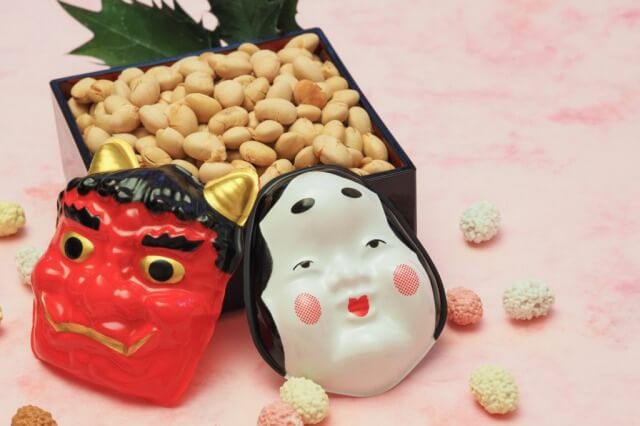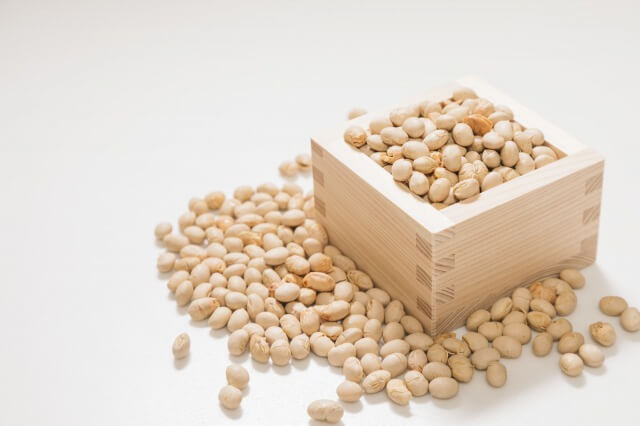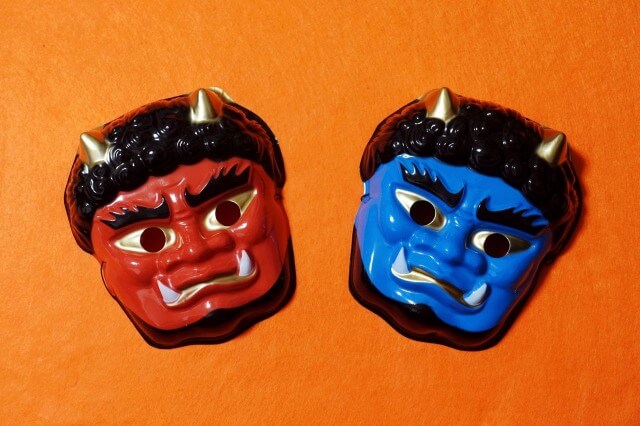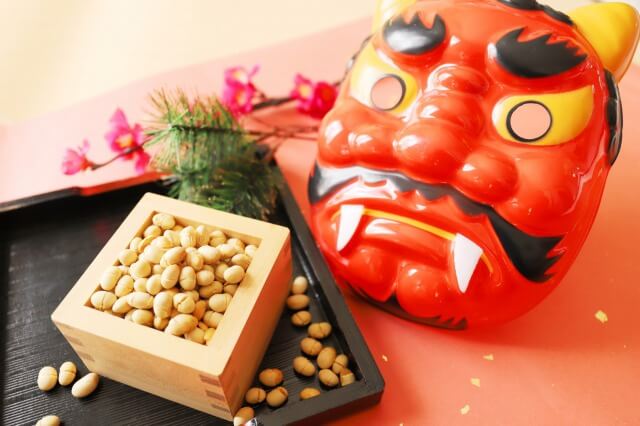
節分を英語で説明|由来や鬼と豆まきなどの行事を7つの例文で紹介

外国人から「節分って何ですか?」と聞かれたら、英語で答えられますでしょうか?
 woman
woman(「節分」って何ですか?)



節分って英語で何て説明すればいいのかしら?
外国人に節分をどうやって説明すればいいのか?
そんな疑問にお答えします。
節分は英語で「the day before the beginning of spring(春の始まりの前日)」です。



(節分とは、春の始まりの前日の日の事です。季節の変わり目には鬼が生じるので、鬼を追い払う行事が行われます。)
節分について英語で説明する例文を一緒に見て行きましょう。
無料でお試しできるオンライン英会話をいくつか紹介します。
節分を英語で説明


Setsubun is the day before the beginning of spring.
節分とは、春の始まりの前日の日の事です。
- Setsubun/節分
- day/日
- before/前
- beginning/始まり
- spring/春
Since demons appear at the turn of the season, an event is held to drive away the demons.
季節の変わり目には鬼が生じるので、鬼を追い払う行事が行われます。
- Since/なので
- demon/鬼
- appear/現れる
- turn of the season/季節の変わり目
- event/行事
- held/hold(催す)の過去形・過去分詞
- drive away/追い払う



(季節の変わり目には鬼が出るのね。)
節分の由来を英語で説明


Originally, Setsubun was the turning point of the season, and there were four days a year, the day before spring, summer, autumn, and winter.
もともと節分は、季節の変わり目のことで、春・夏・秋・冬の前日と、年に4日ありました。
- originally/もともと
- Setsubun/節分
- turning point/変わり目
- season/季節
- four days a year/1年に4日
- day/日
- before/前の
- spring/春
- summer/夏
- autumn/秋
- winter/冬
In the lunar calendar, the New Year began in spring, so Spring Setsubun (around February 3) was New Year’s Eve, and this day was the most important.
旧暦では、春から新年が始まったため、春の節分(2月3日頃)は大晦日にあたり、この日が一番重要視されていました。
- lunar calendar/旧暦
- New Year/新年
- began/begin(始まる)の過去形
- spring/
- Spring Setsubun/春の節分
- around/頃
- February 3/2月3日
- New Year’s Eve/大晦日
- the most important/もっとも重要な(importantの最上級)
Therefore, speaking of Setsubun, it was February 3rd.
そのため、節分と言えば、2月3日の事となりました。
- therefore/それゆえ
- speaking of/と言えば
- Setsubun/節分
- February 3rd/2月3日



(節分とは春の訪れの事なのですね。)
節分の時期を英語で説明


Setsubun is not necessarily February 3rd.
節分は必ずしも2月3日ではありません。
- Setsubun/節分
- necessarily/必ずしも(~でない)
- February 3rd/2月3日
Setsubun is the day before the beginning of spring, and since the beginning of spring is determined by the position of the sun, the date of Setsubun varies from year to year.
節分は立春の前日で、立春は太陽の位置によって決まるため、節分の日付は年によって異なります。
- Setsubun/節分
- day/日
- before/前
- beginning of spring/立春(春の始まり)
- since/だから
- determine/決める
- position/位置
- sun/太陽
- vary/変わる
- from year to year/年々
Until 1984, in the leap year, Setsubun was February 4th.
1984年までは、閏年の場合、節分は2月4日でした。
- until/まで
- leap year/閏年
- Setsubun/節分
- February 4th/2月4日
From 1985 to 2020, Setsubun is February 3rd every year.
1985年から2020年までの間、節分は毎年2月3日となっています。
- Setsubun/節分
- February 3rd/2月3日
- every year/毎年
After 2021, Setsubun is expected to be February 2nd, the year after the leap year.
2021年以降、閏年の翌年は節分は2月2日になると予想されています。
- after/以降、後
- Setsubun/節分
- be expected to be/なると予想される
- February 2nd/2月2日
- year/年
- leap year/閏年



節分の鬼を英語で説明


Demon is a legendary creature in Japan.
鬼は、日本の伝説上の生き物です。
- demon/鬼
- legendary/伝説上の
- creature/生き物
- Japan/日本
Generally, a demon is a big man with horns on his head, fangs on his mouth, and a metal rod in his hand.
一般的に、鬼は頭に角が生え、口には牙が生え、手に金棒を持った大男の姿とされています。
- generally/一般的に
- demon/鬼
- big/大きな
- man/男
- horn/角
- head/頭
- fang/牙
- mouth/口
- metal rod/金棒
- hand/手
The color of the demon’s body varies from red to blue, and it is called “red demon” or “blue demon”.
鬼の体の色は赤や青などさまざまで、「赤鬼」「青鬼」などと呼ばれています。
- color/色
- demon/鬼
- body/体
- vary/様々である
- red/赤
- blue/青
- call/呼ぶ
- red demon/赤鬼
- blue demon/青鬼
In the olden days, it was thought that it was the work of demons that caused horrific things.
昔は、恐ろしい事が起きるのは、鬼の仕業と考えられていました。
- olden days/昔
- it was thought that/と考えられていた
- work/仕業
- demon/鬼
- cause/起こす
- horrific/恐ろしい
- thing/事
It is believed that demons will appear at the turn of the seasons, and various events were held to ward off demons.
季節の変わり目には鬼が生じると信じられており、鬼を追い払うために様々な行事が行われていました。
- believe/信じる
- demon/鬼
- appear/現れる
- turn of the seasons/季節の変わり目
- various/様々な
- event/行事
- be held/開催される
- ward off/追い払う


 A demon appears at the turn of the season.
A demon appears at the turn of the season.
(季節の変わり目には鬼が生じるのね。)
節分の行事|豆まきを英語で説明


On Setsubun day, we sow beans.
節分の日には、豆まきをします。
- Setsubun/節分
- day/日
- sow/まく
- bean/豆
It is believed that soybeans have the power of amulets and that demons can be driven away by throwing roasted beans at them.
大豆には魔除けの力があり炒った豆を鬼投げつけることで鬼を追い払いう事ができると、考えられています。
- it is believed that/と思われる
- soybean/大豆
- power/力
- amulet/魔除け
- demon/鬼
- driven away/
- throw/投げる
- roasted/炒った
- bean/豆
When driving away the demons, we sow beans and says, “Oni is outside, Fuku is inside.”
鬼を追い払うとき、豆を撒きながら「鬼は外、福は内。」と言います。
- drive away/追い払う
- demon/鬼
- sow/まく
- bean/豆
- Oni/鬼
- outside/外
- Fuku/福
- inside/内
Also, by eating as many beans as our age, we hope for the next year without any illness.
また、自分の年齢と同じ数の豆を食べることによって、私たちは今後1年間の無病息災を願います。
- also/また
- eat/食べる
- bean/豆
- age/年齢
- hope/願う
- next/次の
- year/年
- without/無の
- any/どんな~も
- illness/病気



節分の食べ物|恵方巻を英語で説明


It is customary to eat Ehomaki on Setsubun day.
節分の日には恵方巻を食べる習慣があります。
- customary/習慣
- eat/食べる
- Ehomaki/恵方巻
- Setsubun/節分
- day/日
Ehomaki is sushi made by wrapping 7 kinds of ingredients and vinegared rice with seaweed.
恵方巻とは、7種類の具材と酢飯を海苔で巻いたお寿司の事です。
- Ehomaki/恵方巻
- sushi/寿司
- made/make(作る)の過去形・過去分詞
- wrap/巻く
- kind/種類
- ingredient/具材
- vinegared rice/酢飯
- seaweed/海苔
On the day of Setsubun, it is said that it is auspicious to eat Ehomaki silently while facing Eho (the direction in which God is).
節分の日に、恵方(神様のいる方向)を向いて恵方巻を無言で食べると縁起が良いとされています。
- day/日
- Setsubun/節分
- it is said that/と言われている
- auspicious/縁起が良い
- eat/食べる
- Ehomaki/恵方巻
- silently/無言で
- while/ながら
- face/向く
- Eho/恵方
- direction/方向
- God/神



節分の飾り|焼嗅を英語で説明


On the night of Setsubun, it is customary to put sardine heads and other odorous objects in the doorway to drive away demons.
節分の夜には、鰯の頭などの臭いのするものを戸口に置き、鬼を追い払う焼嗅(やいかがし)という習慣があります。
- night/夜
- Setsubun/節分
- customary/習慣的な
- put/置く
- sardine/鰯(いわし)
- head/頭
- other/他の
- odorous/臭いのする
- object/物
- doorway/戸口
- drive away/追い払う
- demon/鬼
It is common to decorate holly sardines made from twigs of holly and roasted sardine heads.
柊(ひいらぎ)の小枝と焼いた鰯の頭から作る柊鰯(ひいらぎいわし)を飾るのが一般的です。
- common/一般的な
- decorate/飾る
- holly/柊
- sardine/鰯
- made from/から作られた
- twig/小枝
- roaste/焼く
- head/頭
It is said that the thorns of the holly leaves pierce the eyes of the demons, and the smoke and smell of burning sardines keep the demons away.
柊の葉の棘が鬼の目を刺す、鰯を焼く煙と臭いで鬼が近寄らないようにすると言われています。
- it is said that/と言われている
- thorn/棘
- holly/柊
- leaves/leaf(葉)の複数形
- pierce/突き刺す
- eye/目
- demon/鬼
- smoke/煙
- smell/臭い
- burn/焼く
- sardine/鰯(いわし)
- keep away/~に近づけない
- demon/鬼



節分を英語で説明|まとめ
いかがでしたでしょうか?
節分といえば、2月3日に豆まきをする日だと思っていましたが、実際には必ずしも節分が2月3日と決まっているわけではないのですね 。
立春とは、太陽黄経が315度となる日なので、今後は2月2日が節分になることもあるようです。
節分の日に、鬼を追い出すために豆を撒くという行事は、余り海外では行われていないようです。
外国人の友人と一緒に家庭で豆撒きをしたり、神社などで開催される豆撒きの行事に連れて行ってあげたりすれば、喜ばれるかもしれませんね。



英会話教室に通う時間もお金もないし。



PCやスマホで気軽に英会話の練習ができます。
アプリなので費用もそんなに高くないですし、自宅で自分のペースで英会話の勉強ができますよ。






こちらも自宅から自分の都合が良い時間に英会話ができますよ。








